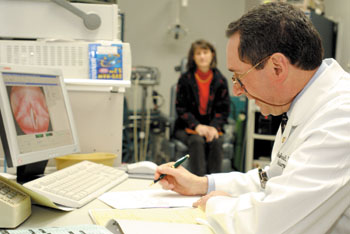
Mary Anne Hoskins kept her problem in the background for two years. At the Vanderbilt Voice Center, Dr. Robert Ossoff’s team removed polyps from her vocal fold, helping restore her voice.(photo by Anne Rayner Pollo)
Pediatric kidney stone clinic opens today
Vanderbilt Children’s Hospital opened a pediatric comprehensive kidney stone clinic today, the first in Tennessee and one of only a few in the nation.
The clinic, a joint project between the divisions of Pediatric Urology and Pediatric Nephrology, will provide comprehensive services for children who are affected by kidney stones.
Tennessee lies in what doctors describe as the “kidney stone belt of the United States,” and because of that, doctors are treating more and more children with kidney stones.
A Vanderbilt team published a study titled “Clinical Outcome of Pediatric Stone Disease” in the February 2002 Journal of Urology, indicating that pediatric patients with kidney stones were less likely to pass those stones due to the size of the stones and were more likely to have developed stones due to a metabolic disorder. The study also called for aggressive treatment.
The study, conducted by Drs. Paul K. Pietrow, John C. Pope, Mark C. Adams, Yu Shyr and John W. Brock, indicated a comprehensive treatment plan and chemical workup should be initiated on all children who present to physicians with kidney stones.
Based on that information, Brock, director of Pediatric Urology, Adams, associate professor of Urologic Surgery and Pediatrics, and Pope, along with Dr. Kathy Jabs, director of Pediatric Nephrology, and Dr. Tray Hunley, assistant professor of Pediatrics, formed the idea for the comprehensive clinic. Pope, assistant professor of Urology Surgery, and Hunley will spearhead the clinic.
Once a patient is referred to the clinic, doctors will meet with the patient, treat the stone if necessary, identify a cause of the kidney stones and map out a long-term care plan.
“We will be a one-stop shop,” explained Pope. “We can begin a treatment plan immediately. It’s very important for us to find out why the child has developed kidney stones and intervene with some solutions. This will impact the kids for the rest of their lives.”
Children who experience kidney stones usually develop them from one of two sources—metabolic abnormalities or infection. The study indicated that half of all children under the age of 10 who presented with kidney stones had an identifiable metabolic disorder. These metabolic disorders produce stones with different chemical compositions and shapes. The four most common types of stones are calcium stones, the most common of the kidney stones, caused by excessive calcium in the urine; struvite stones, also called infection stones, associated with bacterial urinary infections; cystine stones, a rare stone that is often genetic and develops from excessive cystine buildup in the urine; and uric acid stones, stones that develop when urine contains too much uric acid, which is produced when the acid breaks down protein.
“Based on the study results, we know to immediately begin a metabolic workup on every child that presents with stones,” explained Lisa Trusler, MSN, RN, a pediatric clinical nurse specialist and case manager in Urology. “With the comprehensive clinic the doctors can immediately develop a plan for the patient. This makes it easier on the patients and families that are referred.”
Kidney stones are not common in children, however an estimated one million people in the United States develop stones. In adults, kidney stones are the third leading reason for hospitalization and the seventh leading cause for physician visits.
Treatment varies from hydrating the patient to force out the stone to surgically removing the stone.
“Our research has shown that any stone larger than 4 millimeters in size will likely have to be removed surgically,” Pope explained. “Most children are simply not going to pass a stone that large.”
The Comprehensive Kidney Stone Clinic will see patients once a month while doctors gauge the volume of interest and number of patients. The next clinic is scheduled for April 26. The clinic meets in suite 435, Medical Arts Building. For more information call 936-1060.













